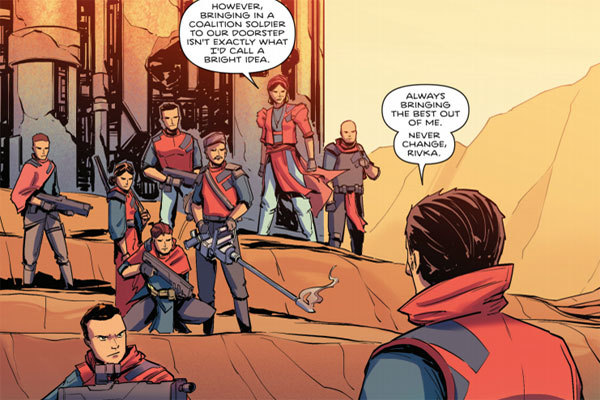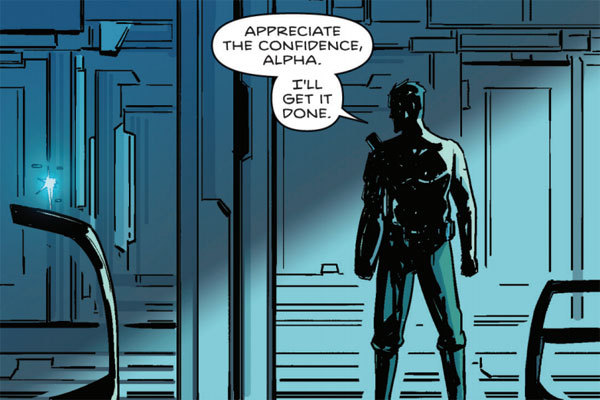Bright and pastel, Wayfinder’s first chapter stimulates with an intense standoff, exhilarating banter, and explosive character introductions. Written craftily and drawn cleanly by Sachi Ediriweera with colours by Warnia Sahadewa and letters by Micha Myers, this introduction to Wayfinder is fun, entertaining, and piques softly at the reader’s interest.
Set in the dissonant year of 2243 in the light-washed land of Kolumpor, this first chapter dives promptly into the story with a series of expositions. It works swiftly to introduce the characters and highlight what may become important plot points to the overarching story of the finished graphic novel. Anu is a rogue space engineer, crash-landing into earth in search of her daughter. Along the way she is met by military personnel with a mission to take her in. From there, the rest of the story flows and culminates, shifting smoothly between tones in dialogue.
Ediriweera’s use of dialogue is flawless. I appreciate Anu’s quick aggressive whips that sharply counters the stern and serious edge of Kian’s tone of voice. This clash of diplomatic tones from the members of the military, and rough and sarcastic tones from outsider characters, is an excellent form of character and world building; the conversations taking place and character speeches all feel very natural. As a first chapter, it does well in establishing personalities and dynamic using dialogue. However, I feel the efforts made to create a tense atmosphere with text and character interaction in several pages of build-up does feel a little bit wasted as an anticlimactic end comes to the stand-off.
The art style uses clean lines and smooth landscaping to evoke calmness and serenity. Character designs are simplistic and typical, yet lends itself to expressive facial features which aids in adding to the tone of the conversations, as well as help define characters. Alongside the art is the bright pastel colour palette which is used in synergy with the nature-driven scenery, seen in radiance through the linear shift in colour to accent the passage of time.
This is a pretty and charming stylistic choice of visual storytelling. However, often times the lighting whitewashes darker skinned characters in certain panels. It also creates friction between the tone of dialogue and the atmosphere created by the visual representation of the scenes. The linear design of the panels makes the story easy to follow and resolves this friction a little bit, but it also breaks tension and reduces anticipation with each line of complacent dialogue. The most appealing use of colour and art in this chapter is the protruding sunset hue throughout the panels building up to the last page. This did well in stimulating my curiosity, and also heightened the impact of that last scene in particular.

Both the art and dialogue blend well to showcase the strong resolve of the characters during the standoff, which is a testament to how well the art style lends itself to progressing the story and defining the characters. It is a bold choice to use an ambient colour palette the urgent tone of the text; done well, it could make for excellent juxtaposition. In this particular piece though, I feel like it has missed the mark. Its purpose baffles me, and while I understand that colour is used so far to depict the passage of time, the brightness of it in the stand-off throws off the tense atmosphere and confuses the tone of the story. One instance in this chapter where the text worked well with the colour palette is in the last panel of Kian’s solitary scene; the blues and shadows work well and compliment Kian’s edgy resolve.

I found Wayfinder entertaining in its dialogue-driven characterization and intriguing plot. The visual harmony of colour and art was stunning to look and made the read enjoyable. It does however seem to fall a little apart at the seams with the definitive clash of colour and text. Still, I was deeply entranced by the chapter altogether. Perhaps Ediriweera’s flawless use of dialogue and excellent characterization strongly overshadowed any minor disconnect I found with the piece.
Interested in what happens in the rest of Wayfinder? You can follow Sachi Ediriweera’s work here! Be sure to let us know what you think in the comments below or send us your thoughts on Twitter!

